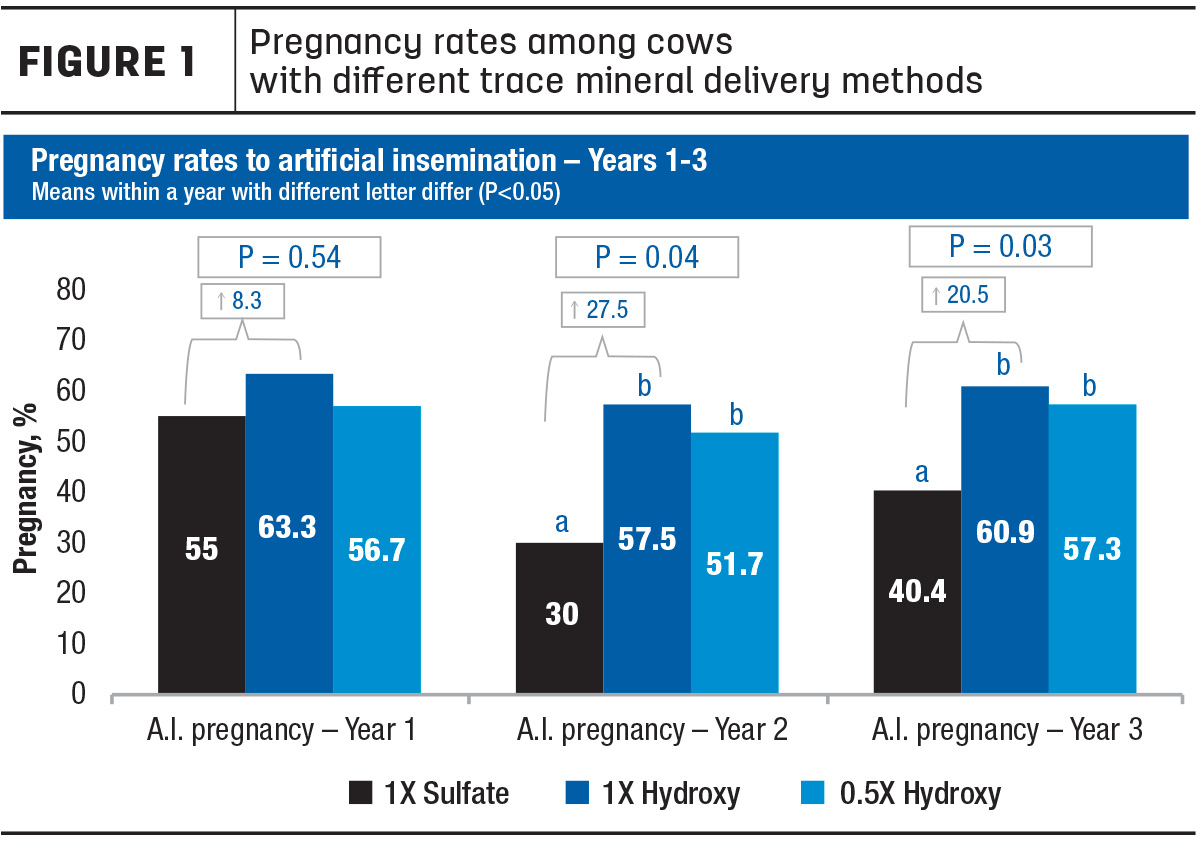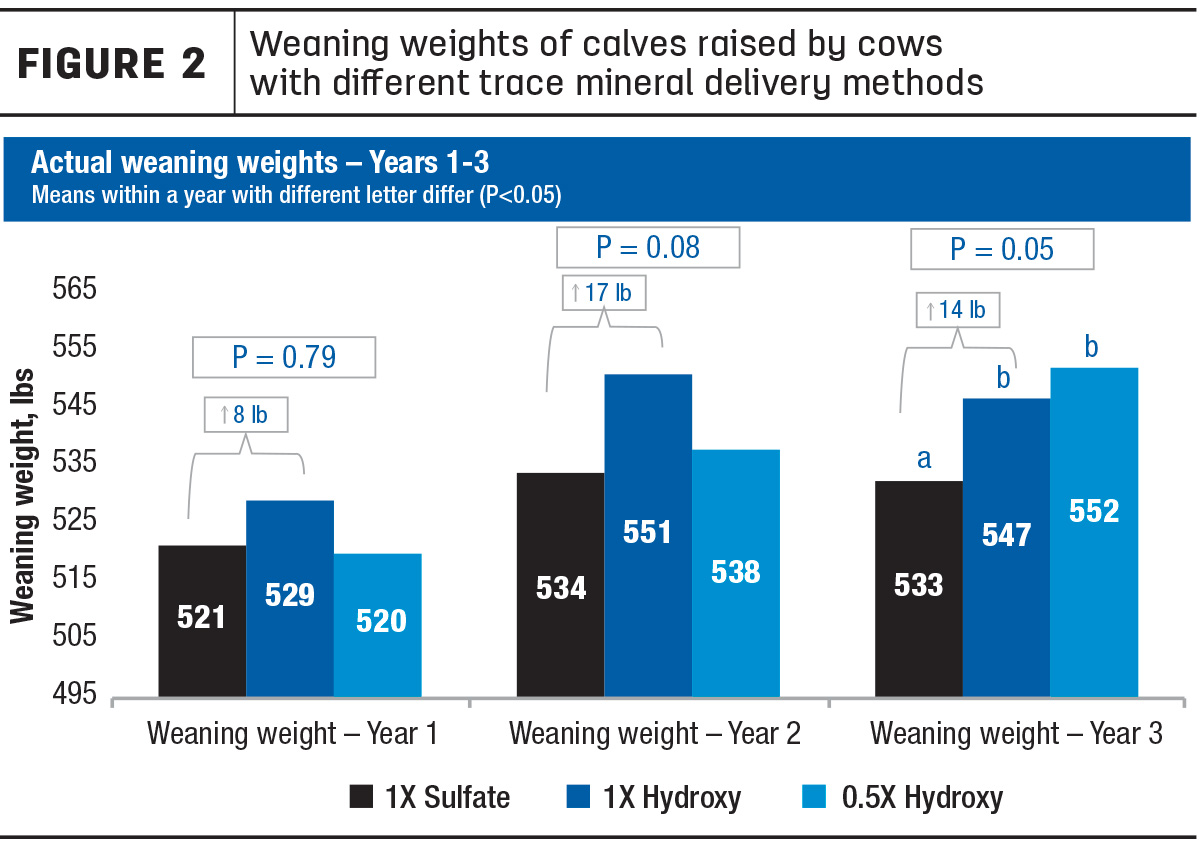What makes a trace mineral program more appropriate and more profitable? Several factors should be evaluated to completely answer this question. However, it appears obvious to me that most trace mineral programs can be dramatically fine-tuned by carefully evaluating the trace mineral source and level being fed. These two factors in trace mineral supplementation can make an enormous difference in cattle performance and profitability.
The issue
The focus of this article will be on the value of copper, manganese and zinc supplementation to the cow-calf enterprise. Why? This sector of beef production has unequaled variability in the source and level of copper, manganese and zinc supplemented to brood cows. It is astounding. This reality begs the question: Why such variability across the industry? The established requirements for these trace minerals haven’t changed through multiple versions of the National Research Council/National Academies of Sciences, Engineering and Medicine (NRC/NASEM) publication. There are mineral supplement feed tags with less than 1X NASEM (2016) requirement up to 3X NASEM (2016) requirement for these trace minerals.
Furthermore, the past several years of mineral research have shed light on the major nutritional and economic differences in trace mineral sources. Specifically, the past 10 years have adequately shown the pitfalls of using sulfate sources of copper, manganese and zinc. There are more improved sources available that offer numerous advantages to sulfate sources. With this knowledge of published requirements and research evaluating sulfate sources of trace minerals relative to an improved source, supplementation in a correct and profitable manner can be more appropriately achieved.
Trace mineral source
Hydroxychloride sources of copper, manganese and zinc are relatively new to the beef industry compared to other sources. They are an improved source relative to sulfates because of their unique chemistry, which also makes them very inexpensive relative to other improved sources such as organic trace minerals. In recent years, hydroxychloride sources of copper, manganese and zinc have been scientifically proven to improve mineral bioavailability, mineral palatability, vitamin stability and fiber digestibility in diets compared to sulfate sources.
Hydroxychloride copper has been proven to be more bioavailable to beef cattle than copper sulfate in the presence of antagonists such as sulfur and molybdenum. Furthermore, hydroxychloride zinc has been proven to be more bioavailable to beef cattle than zinc sulfate. Mineral supplements utilizing hydroxy sources are preferentially consumed by beef calves over sulfate and organic sources – via free-choice loose mineral supplements, via mineral-fortified energy supplements and via cooked molasses-based mineral tubs.
Regardless of the supplementation strategy, hydroxychloride trace minerals improved mineral supplement palatability. Using hydroxychloride copper instead of copper sulfate in diets has drastically improved vitamin E stability in feeds and improved vitamin E status in animals. With a medium-quality grass hay as the basal diet, beef steers had greater fiber digestibility when supplemented with hydroxychloride trace minerals compared with sulfate sources of copper, zinc and manganese. It is obvious that sulfate sources of copper, manganese and zinc are detrimental to many facets of beef cow nutrition compared with an improved source like hydroxychlorides. Do these advantages in hydroxy trace minerals translate to production responses that translate to profitability? We’ll get to that.
Trace mineral level
Because sulfate sources of copper, manganese and zinc are cheap, quite often those ingredients are included in mineral supplement formulations above what is truly required. Is this a potential problem? Before we answer that question, let’s ask some others: Why is this practice of “overformulation” done to begin with? Why are there so many mineral supplement formulas with 2X and 3X NASEM (2016) requirements available to producers? Well, let’s be frank: How many times have we picked one mineral supplement over another just because it had more copper, more zinc or more whatever? Human nature says, “More is better.” But we must remember, these are micro/trace minerals that are very important but needed in small amounts per day.
Back to the original question – Is it a potential problem to overfeed sulfate trace minerals for the sake of “tag dressing?” It really doesn’t take a long review of the peer-reviewed research to see that overfeeding sulfate trace minerals could lead to production issues. A study conducted in 2000 by researchers at Colorado State University compared the supplementation of copper, manganese and zinc at 0.5X NRC from sulfate sources, 1X NRC from sulfate sources and 1X NRC from an improved organic source. The 1X NRC organic treatment had higher A.I. pregnancy rate than both sulfate treatments. Interestingly, the increased level of trace minerals (1X NRC) for both organic and sulfate treatments allowed for greater liver copper concentration, but the 1X NRC sulfate treatment still had a negative effect on reproduction. Even more interesting, the 1X NRC sulfate cows lost significantly more bodyweight than other treatments, primarily during the first part of the trial. There is definitely some food for thought from the results of this trial.
Pulling it all together
Recently, a three-year study was conducted by Colorado State University in eastern Colorado through three production cycles. This study compared 1X NASEM requirement of copper, manganese and zinc with sulfate; 1X NASEM requirement of copper, manganese and zinc with hydroxychloride; and 0.5X NASEM requirement of copper, manganese and zinc with hydroxychloride trace minerals. The different mineral sources and levels were fed to cows throughout the three-year study via a free-choice mineral supplement conducive with eastern Colorado range.

Cow bodyweight and body condition score were similar (P of 0.91 or greater) across treatments over the course of the study. Liver copper, zinc and manganese concentrations and pregnancy rate to A.I. were greater (Figure 1; P less than 0.05) in cows receiving both levels of hydroxychloride trace minerals compared with the sulfate cows after years two and three of the study.

Furthermore, actual calf weaning weights were greater (Figure 2; P less than 0.05) in both levels of hydroxychloride-supplemented animals compared to sulfate after year three of mineral supplementation. Hydroxychloride copper, zinc and manganese supplementation (at the same and lower levels) improved liver status, pregnancy rate to A.I. and actual weaning weights of calves compared to sulfate sources of copper, zinc and manganese. Do these performance outcomes lead to profitability? The 0.5X NASEM treatment with hydroxychloride is basically an equal investment to the 1X NASEM treatment with sulfate. In this study, the increased investment by feeding 1X NASEM with hydroxychloride is about $3.50 per cow more per year – not much. With the additional weaning weight gained from the hydroxychloride treatment in this study, the advantage is $40 to $50 per cow using current market prices. Trace mineral source matters and more is not always better when it comes to copper, manganese and zinc supplementation. Using improved and cost-effective sources at appropriate levels is the right thing to do if profitability is your goal.
References omitted but are available upon request by sending an email to the editor.












